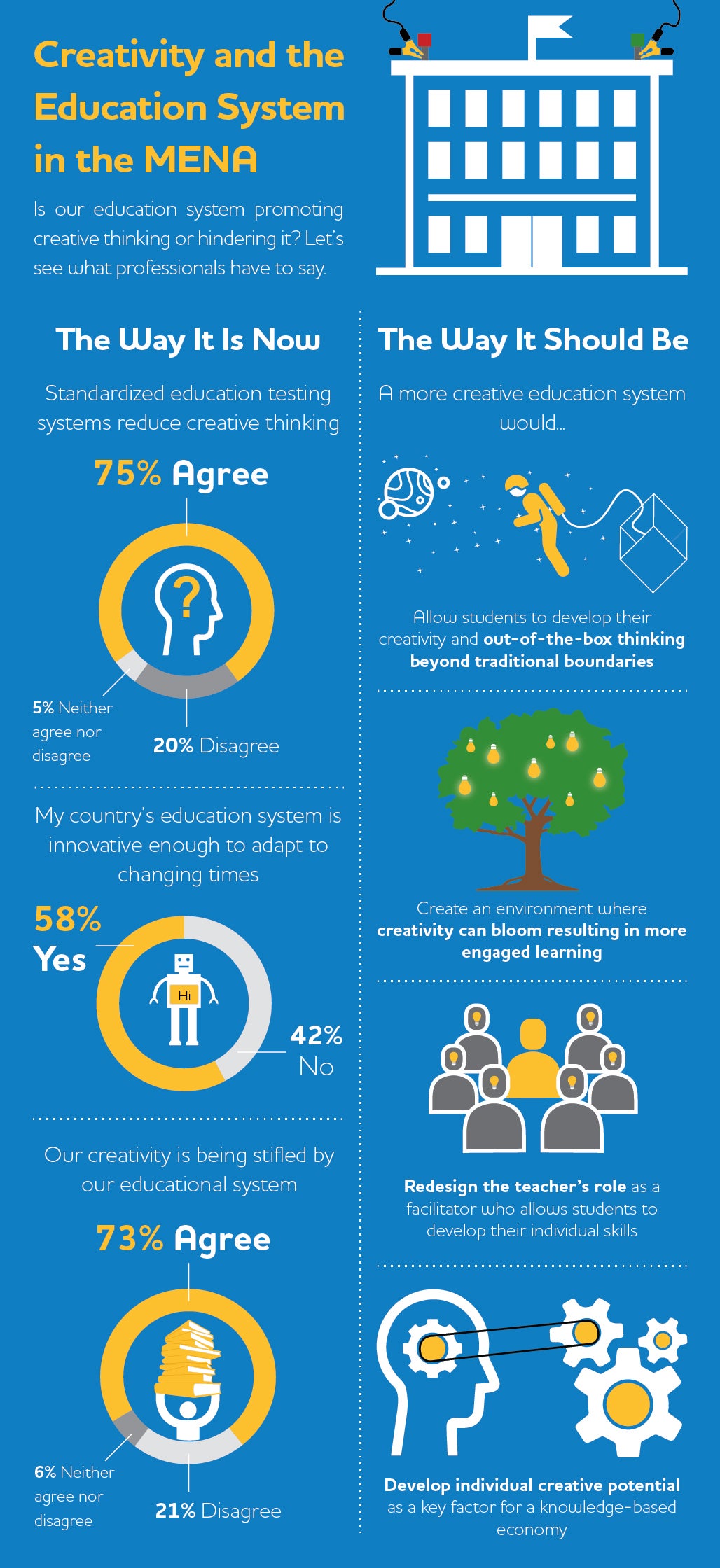Invigorate Your Team In 10 Steps Bayt's Lama Ataya gives tips on how an organization can differentiate innovation and creativity, and encourage both.
By Lama Ataya
Opinions expressed by Entrepreneur contributors are their own.
You're reading Entrepreneur Middle East, an international franchise of Entrepreneur Media.

There was a time when the concepts of creativity and innovation were only associated with artists and scientists. But with the ever-increasing necessity of cultivating a unique brand and value proposition, the need for innovation and creativity has transitioned from science and arts into everyday business. But what is innovation? What is creativity? What is the difference between innovation and creativity? But most importantly, which is more important to your organization?
What is the difference between innovation and creativity?
When it comes to innovation versus creativity, opinions diverge. One of the definitions out there relates to the practicality of these terms. Some say that creativity refers to the ability to come up with new ideas or new ways to approach old problems, whereas innovation is the ability to confine these creative ideas and make them turn into reality. In other words, creative ideas are thought experiments within one person's mind. Innovation, on the other hand, is concerned with the actual implementation of an idea. An organization can use innovation to convert its creative resources into appropriate solutions and reap a return on its investment. Because people are often unclear about the exact meanings of these two terms, organizations often chase creativity, but what they really need to pursue is innovation.
How innovative are organizations in the Middle East?
In 2014, Bayt.com conducted a poll to measure the extent to which organizations in MENA are perceived to be innovative– the Bayt.com Innovation in the MENA Workplace poll (January 2014). The results were quite positive, revealing how valued and encouraged innovation is between employees and customers. For example, the poll showed that 83% of respondents claim their organizations have long-term innovation strategies. The poll revealed improved financial performance within participating companies, with seven out of 10 (69.4%) claiming that their companies are up to date with other establishments in their domain. The majority (82.9%) said that their companies instill long-term innovation plans rather than short-terms ones, which has put them ahead in the industry.
Teamwork and collaboration play an important role in the rise of a company's success, having 81.1% of respondents claiming that pitching ideas and reaching out to other divisions is highly encouraged and supported, to the point where involving customers in feedback is essential in the betterment of the company's success.

The Bayt.com Education and Innovation in the Middle East and North Africa poll, February 2015, shows that both creativity and innovation are viewed as important by Middle Eastern professionals. 89% agree that creative thinking is important for driving social and economic growth. In the region, the UAE is perceived to be the most creative country, according to 51.5% of respondents. On the career front, the majority of respondents (88.5%) agree that creative thinking and related skill sets are important for getting a job in today's market, as people are increasingly being asked to think creatively at work (according to 86.9%). Another 72.1% claim that their office has creative spaces in which they can relax, unwind and innovate.
The biggest challenge to creativity is money, according to 42% of respondents. Other factors that stifle creativity and innovation in the region are lack of knowledge and tools (15.8%), age (10.1%), and not enough time (9%). When respondents were asked whether standardized education systems stifle creative thinking, the majority agreed (73%). Moreover, 41.9% believe that their country's education system is not innovative enough to adapt to changing times.
Is yours an innovative organization?
Innovation needs to be carried out by everyone and on all fronts. In fact, focusing on innovation has been identified as a way to encourage learning and growth in an organization. Unfortunately, many managers don't innovate because they don't think it is their job to do so. We say that innovation is everyone's job. Great organizations don't depend on a small number of exclusive people to come up with innovations. Instead, they create a culture in which every employee is encouraged and empowered to innovate. A thriving innovation culture leads not only to new customer offerings but also to better margins, stickier customer relationships, and stronger partnerships with other firms. 62% of respondents in the Bayt.com Innovation in the MENA Workplace poll say that innovation has led to improved financial performance for their company; 64% agree that their organization is more innovative compared to competition. There are many pieces to the innovation puzzle, and they will come together differently for each organization. How one goes about building an innovative organization ought to be unique. But for every organization, innovation starts with the following steps:
1. Give employees a reason to care. The fact is, if people aren't feeling connected to your company, there's little incentive for them to be innovative. Make sure your employees are in the loop on your firm's strategies and challenges, and invite their input. Employees who are involved early on in processes and plans will be motivated to see them through to completion.
2. Stress the importance of innovation. Ensure all your employees know that you want to hear their ideas. Unless they understand how innovating your business processes can keep your firm competitive, your efforts at encouraging creative thinking risk falling flat.

3. Schedule time for brainstorming. Allocate time for new ideas to emerge. For example, set aside time for daily or weekly brainstorming, hold regular group workshops and arrange team days out. A team involved in a brainstorming session is likely to be more effective than the sum of its parts. You can also place suggestion boxes around the workplace, ask for solutions to solve particular problems, and always keep your door open to new ideas.
4. Train staff in innovation techniques. Your staff may be able to bounce an idea around, but be unfamiliar with the skills involved in creative problem-solving. You may find training sessions in formal techniques such as lateral thinking and mind-mapping extremely worthwhile.
5. Encourage change. Broadening people's experiences can be a great way to spark ideas. Short-term job swaps can introduce a fresh perspective to job roles. Encourage people to look at how other businesses do things, even those in other sectors, and consider how they can be adapted or improved.
6. Challenge the way staff work. Encourage employees to keep looking anew at the way they approach their work. Ask people whether they have considered alternative ways of working and what might be achieved by doing things differently.
7. Be supportive. Respond enthusiastically to all ideas and never make someone offering an idea feel foolish. Give even the most apparently eccentric of ideas a chance to be aired. You can't force creativity, but the right support system will put your team in the right frame of mind to find imaginative solutions.
8. Tolerate mistakes. A certain amount of risk-taking is inevitable with innovation. Allow people to learn from their mistakes. Never put off the creative flow by penalizing those whose ideas don't work out.
9. Reward creativity. Motivate individuals or teams who come up with winning ideas by actively recognizing innovation, for example, through an awards scheme. You could even demonstrate your recognition that not all ideas work out by rewarding those who just have a rich flow of suggestions, regardless of whether or not they are put into action at work.
10. Act on ideas. Remember, innovation is only worthwhile if it results in action. Provide the time and resources to develop and implement those ideas worth acting upon. Failure to do so not only means your firm will fail to benefit from innovation, but flow of ideas may well dry up if employees feel the process is pointless.
 How it worked for us
How it worked for us
Over the years, Bayt.com has won numerous Great Place to Work awards. What makes Bayt.com a top place to work is a very firm belief that is proudly shared across the organization; it is the belief that the work we do at Bayt.com is very directly and profoundly helping the communities we serve. In fact, the overall feeling throughout Bayt.com's offices is that employees are involved in something much bigger and better than merely a job; they are involved in making the region a better, richer, more prosperous place.
At Bayt.com, our most important asset is our people. We put considerable time and effort to ensure that we have an empowering culture that focuses on innovation. This includes providing top-class training, ongoing support, and a working environment that fosters creativity, teamwork and the development of new ideas. It is this combination of sophisticated training and mentoring opportunities and the culture of innovation that have allowed Bayt.com to remain at the vanguard of its industry both in terms of cutting-edge technology and in terms of client service and support.
Today, our team is able to proactively anticipate the needs of our communities rather than simply reacting to them. This is very evident in the number of pioneering product and service offerings and enhancements we have introduced to serve our communities better, including Bayt.com Branded Career Channels (also known as "Talentera') Bayt.com Virtual Job Fairs, and other enhanced jobseeker and employer solutions that remain the most sophisticated tools in our industry today.
Innovation never ends
There's no shortage of books and resources with varying methodologies that can help you get started if you're looking to adopt more formal innovation processes. If you're not quite there, encouraging employees to become more curious thinkers could be a first step toward a culture that seeks new solutions for everyday challenges. In fact, it is human curiosity that leads people to pioneer new cures for diseases, more efficient forms of energy and new ways to see the world. You don't need to hire a team of geniuses to achieve innovation, but you do need to give your workforce the confidence, support and incentive to solve the problems around them, until problem-solving becomes just another part of the company culture.











